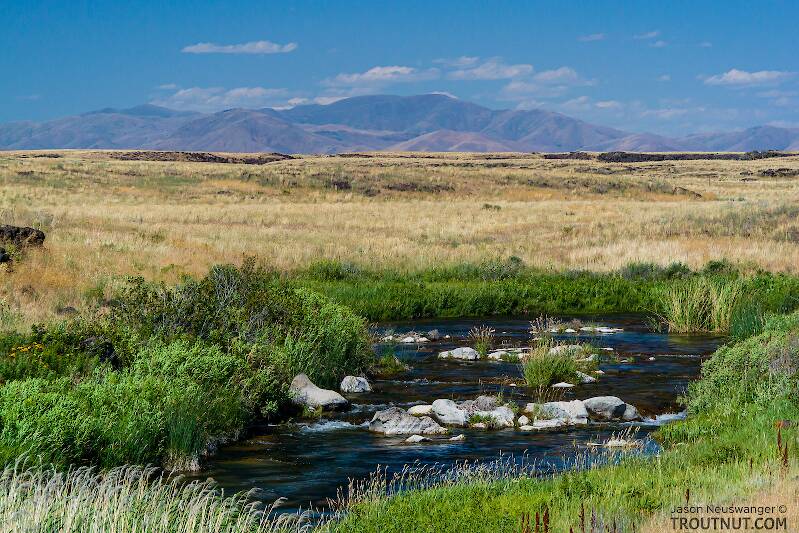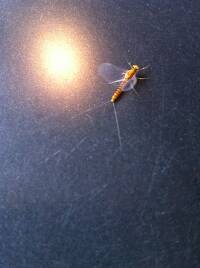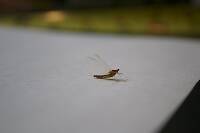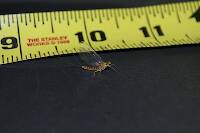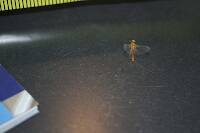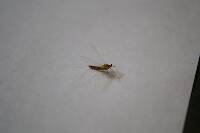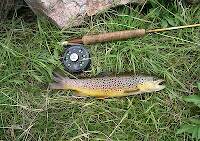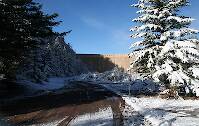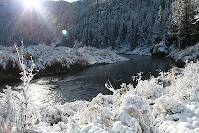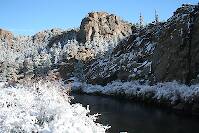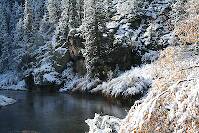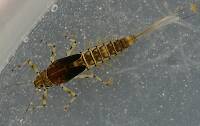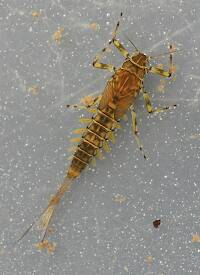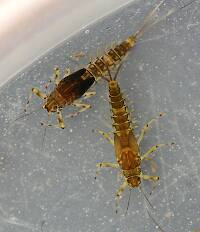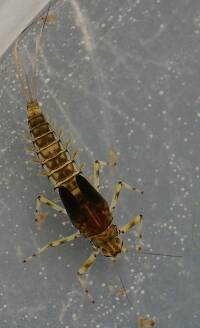
Blue-winged Olives
Baetis
Tiny Baetis mayflies are perhaps the most commonly encountered and imitated by anglers on all American trout streams due to their great abundance, widespread distribution, and trout-friendly emergence habits.
Featured on the forum

It's only barely visible in one of my pictures, but I confirmed under the microscope that this one has a prosternal horn and the antennae are mid-way between the eyes and front of the head capsule.
I'm calling this one Pycnopsyche, but it's a bit perplexing. It seems to key definitively to at least Couplet 8 of the Key to Genera of Limnephilidae Larvae. That narrows it down to three genera, and the case seems wrong for the other two. The case looks right for Pycnopsyche, and it fits one of the key characteristics: "Abdominal sternum II without chloride epithelium and abdominal segment IX with only single seta on each side of dorsal sclerite." However, the characteristic "metanotal sa1 sclerites not fused, although often contiguous" does not seem to fit well. Those sclerites sure look fused to me, although I can make out a thin groove in the touching halves in the anterior half under the microscope. Perhaps this is a regional variation.
The only species of Pycnopsyche documented in Washington state is Pycnopsyche guttifera, and the colors and markings around the head of this specimen seem to match very well a specimen of that species from Massachusetts on Bugguide. So I am placing it in that species for now.
Whatever species this is, I photographed another specimen of seemingly the same species from the same spot a couple months later.
I'm calling this one Pycnopsyche, but it's a bit perplexing. It seems to key definitively to at least Couplet 8 of the Key to Genera of Limnephilidae Larvae. That narrows it down to three genera, and the case seems wrong for the other two. The case looks right for Pycnopsyche, and it fits one of the key characteristics: "Abdominal sternum II without chloride epithelium and abdominal segment IX with only single seta on each side of dorsal sclerite." However, the characteristic "metanotal sa1 sclerites not fused, although often contiguous" does not seem to fit well. Those sclerites sure look fused to me, although I can make out a thin groove in the touching halves in the anterior half under the microscope. Perhaps this is a regional variation.
The only species of Pycnopsyche documented in Washington state is Pycnopsyche guttifera, and the colors and markings around the head of this specimen seem to match very well a specimen of that species from Massachusetts on Bugguide. So I am placing it in that species for now.
Whatever species this is, I photographed another specimen of seemingly the same species from the same spot a couple months later.

Troutnut is a project started in 2003 by salmonid ecologist Jason "Troutnut" Neuswanger to help anglers and
fly tyers unabashedly embrace the entomological side of the sport. Learn more about Troutnut or
support the project for an enhanced experience here.

This dun molted most of the way into a spinner (though the wings got stuck) the evening after I photographed it, so I took some more photos of the spinner.
I found a female nearby, probably of the same species.
I found a female nearby, probably of the same species.
Martinlf on Jan 30, 2016January 30th, 2016, 8:27 am EST
So, in about a month olives will be hatching heavily in Central PA. Does anyone have a favorite pattern or secret weapon? Mine is a klinkhamer style emerger tied to match the natural, with a white or orange post for those slate grey days when I can't see anything on the water. If the fish seem picky, I'll go to a dun post, though.
"He spread them a yard and a half. 'And every one that got away is this big.'"
--Fred Chappell
--Fred Chappell
PaulRoberts on Jan 30, 2016January 30th, 2016, 9:52 am EST
I use a Comparadun and a CDC parachute for the unsophisticated little trout I now fish for, although "sophistication" is often associated with water type. Some flatwater stretches and pools I fish can be challenging.
Martinlf on Jan 30, 2016January 30th, 2016, 4:51 pm EST
Paul, how do you tie your CDC parachute? Do you use the CDC for hackle, like Shane Stalcup and Ed Engle do? I've tied a few of these, and like the design. I've become a fan of CDC comparaduns of late, having them work very well a time or two.
"He spread them a yard and a half. 'And every one that got away is this big.'"
--Fred Chappell
--Fred Chappell
PaulRoberts on Jan 31, 2016January 31st, 2016, 4:16 am EST
No, CDC for the post. And regular deer hair Comparaduns. I also fish mergers of rabbit foot hairs (akin to the Usual) and goose "downy barbs" used as a dubbing ball, and an indicator hackled fly too. All are pretty standard designs nowadays.
Quick Reply
Related Discussions
Topic
Replies
Last Reply
Re: Best of the Best, I've seen all the patterns, what of each is everyone's tried and true.
In Fly Tying by Bcvizina
In Fly Tying by Bcvizina
13
Apr 26, 2010
by KerryWhite
by KerryWhite
6
Dec 19, 2006
by DeRidder
by DeRidder
7
Apr 27, 2010
by Wiflyfisher
by Wiflyfisher

